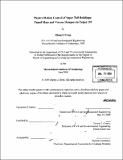Passive motion control of super tall buildings : tuned mass and viscous dampers in Taipei 101.
Author(s)
Gong, Zheng Li
DownloadFull printable version (30.32Mb)
Other Contributors
Massachusetts Institute of Technology. Dept. of Civil and Environmental Engineering.
Advisor
Jerome J. Connor.
Terms of use
Metadata
Show full item recordAbstract
As tall buildings keep becoming taller, they become more susceptible to dynamic excitations such as wind and seismic excitations. One way to reduce structural vibration under dynamic excitations is by placing damping devices in the buildings. In this thesis, the design concept, design procedure and some current applications of tuned mass and viscous dampers are discussed. Taipei101 was used as an example to compare the performance of the two damping schemes. It was modeled in a two-dimensional scheme in SAP2000 and a TMD was placed on its top to study its effect on the structural response due to wind and seismic excitations and confirm with the actual results. A sensitivity study was then performed to study the effect of varying the mass ratio on the structural response. A second TMD was then placed at the location where the maximum deflection occurs for the second mode to evaluate its effectiveness in reducing structural response. Finally, twelve viscous dampers were placed in the model to study their effects on the structural response. Time-history and steady-state analysis in SAP2000 were used for the wind and seismic analyses.
Description
Thesis (M. Eng.)--Massachusetts Institute of Technology, Dept. of Civil and Environmental Engineering, 2009. Includes bibliographical references (leaves 50-51).
Date issued
2009Department
Massachusetts Institute of Technology. Department of Civil and Environmental EngineeringPublisher
Massachusetts Institute of Technology
Keywords
Civil and Environmental Engineering.